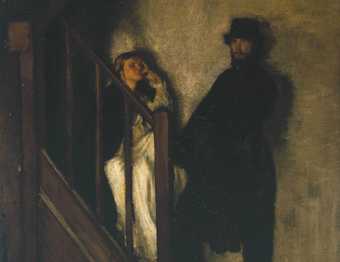
William Rothenstein
The Doll’s House 1899–1900
Oil paint on canvas
889 x 610 mm
Tate N03189
© The estate of Sir William Rothenstein. All Rights Reserved 2010 / Bridgeman Art Library
An early sketchbook owned by Tate, analysed here for the first time, informs this thorough investigation of Rothenstein’s early development, focusing on a painting long considered the artist’s most important work.

William Rothenstein
The Doll’s House 1899–1900
Oil paint on canvas
889 x 610 mm
Tate N03189
© The estate of Sir William Rothenstein. All Rights Reserved 2010 / Bridgeman Art Library
A personal memento of a memorable summer holiday, an illustration of Ibsen’s famous play of a similar name, a tribute to Rembrandt or the origin of a series of influential interiors: there are many ways to read William Rothenstein’s 1899–1900 The Doll’s House.
This In Focus project shows the importance of considering the painting in all of these contexts and more, presenting The Doll’s House as a painting that questions the very point of paintings during a critical period in British art history. Should a painting tell a story, and if so, how? What was appropriate subject matter? How should an artist set about trying to represent reality? Drawing on extensive archival material combined with recent scholarly discussion, the project looks closely at the circumstances surrounding the painting’s conception, exhibition and reception, comparing it to the work of contemporaries of Rothenstein such as Walter Sickert and William Orpen.
Published in February 2016, the project is authored by Dr Samuel Shaw (Yale Center for British Art) with a contribution by Dr William Rough (University of St Andrews).
ISBN 978-1-84976-421-6